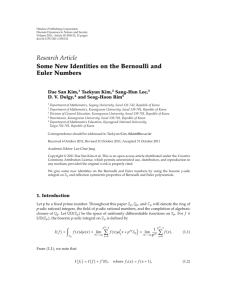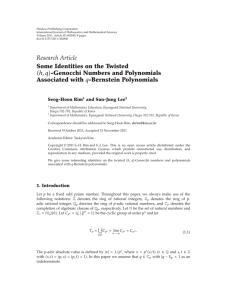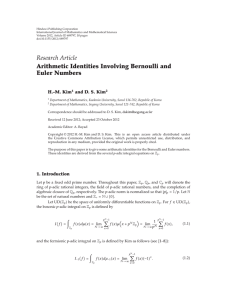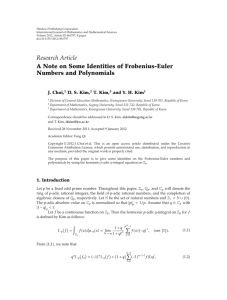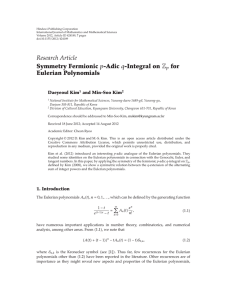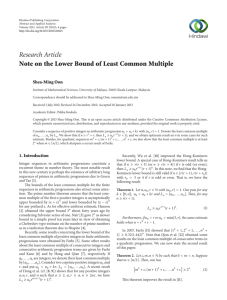Document 10454993
advertisement
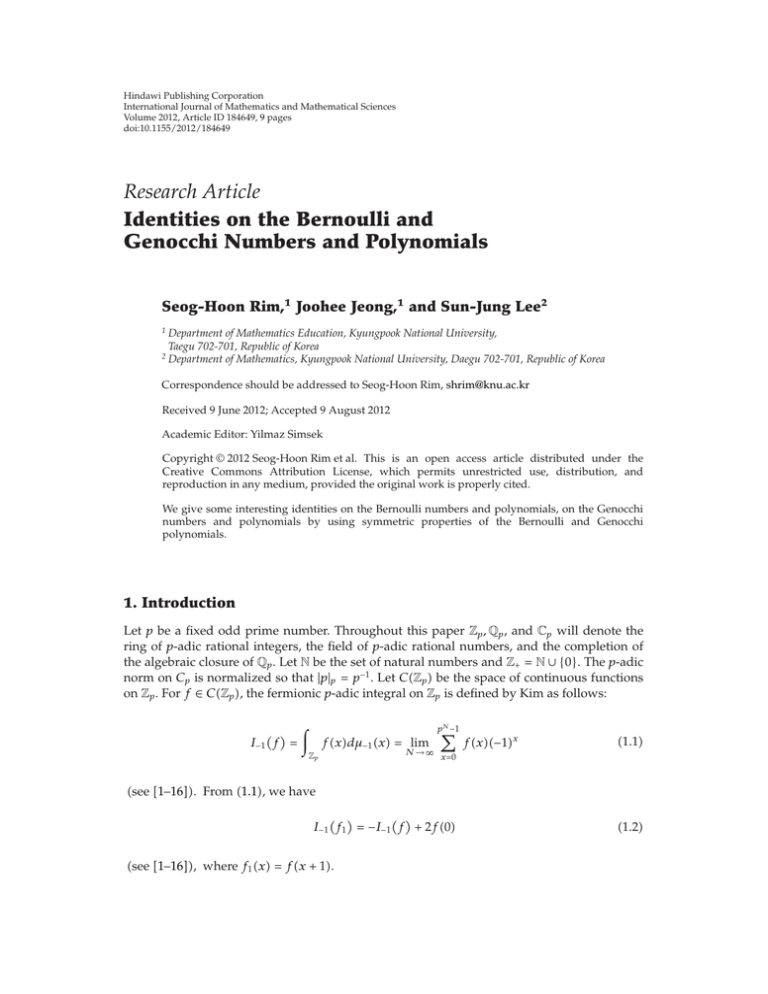
Hindawi Publishing Corporation
International Journal of Mathematics and Mathematical Sciences
Volume 2012, Article ID 184649, 9 pages
doi:10.1155/2012/184649
Research Article
Identities on the Bernoulli and
Genocchi Numbers and Polynomials
Seog-Hoon Rim,1 Joohee Jeong,1 and Sun-Jung Lee2
1
Department of Mathematics Education, Kyungpook National University,
Taegu 702-701, Republic of Korea
2
Department of Mathematics, Kyungpook National University, Daegu 702-701, Republic of Korea
Correspondence should be addressed to Seog-Hoon Rim, shrim@knu.ac.kr
Received 9 June 2012; Accepted 9 August 2012
Academic Editor: Yilmaz Simsek
Copyright q 2012 Seog-Hoon Rim et al. This is an open access article distributed under the
Creative Commons Attribution License, which permits unrestricted use, distribution, and
reproduction in any medium, provided the original work is properly cited.
We give some interesting identities on the Bernoulli numbers and polynomials, on the Genocchi
numbers and polynomials by using symmetric properties of the Bernoulli and Genocchi
polynomials.
1. Introduction
Let p be a fixed odd prime number. Throughout this paper Zp , Qp , and Cp will denote the
ring of p-adic rational integers, the field of p-adic rational numbers, and the completion of
the algebraic closure of Qp . Let N be the set of natural numbers and Z N ∪ {0}. The p-adic
norm on Cp is normalized so that |p|p p−1 . Let CZp be the space of continuous functions
on Zp . For f ∈ CZp , the fermionic p-adic integral on Zp is defined by Kim as follows:
I−1 f Zp
fxdμ−1 x lim
N →∞
N
p
−1
fx−1x
1.1
x0
see 1–16. From 1.1, we have
I−1 f1 −I−1 f 2f0
see 1–16, where f1 x fx 1.
1.2
2
International Journal of Mathematics and Mathematical Sciences
Let us take fx ext . Then, by 1.2, we get
t
Zp
ext dμ−1 x ∞
tn
2t
Gn ,
t
n!
e 1 n0
1.3
where Gn are the nth ordinary Genocchi numbers see 8, 15.
From the same method of 1.3, we can also derive the following equation:
t
Zp
exyt dμ−1 y ∞
tn
2t xt ,
e
G
x
n
n!
et 1
n0
1.4
where Gn x are called the nth Genocchi polynomials see 14, 15.
By 1.3, we easily see that
n n
Gn x Gl xn−l
l
l0
1.5
see 15. By 1.3 and 1.4, we get Witt’s formula for the nth Genocchi numbers and
polynomials as follows:
Zp
xn dμ−1 x Gn1
,
n1
Zp
n
Gn1 x
,
x y dμ−1 y n1
for n ∈ Z .
1.6
From 1.2, we have
Zp
x 1n dμ−1 x Zp
xn dμ−1 x 2δ0,n ,
1.7
where the symbol δ0,n is the Kronecker symbol see 4, 5.
Thus, by 1.5 and 1.7, we get
G 1n Gn 2δ1,n
1.8
see 15. From 1.4, we can derive the following equation:
Zp
n
1 − x y dμ−1 y −1n
Zp
n
x y dμ−1 y .
1.9
By 1.6 and 1.9, we see that
Gn1 1 − x
Gn1 x
−1n
.
n1
n1
Thus, by 1.10, we get Gn1 2/n 1 −1n Gn1 −1/n 1.
1.10
International Journal of Mathematics and Mathematical Sciences
3
From 1.5 and 1.8, we have
Gn1 1
Gn1
Gn1 2
2−
2
− 2δ1,n1 .
n1
n1
n1
1.11
The Bernoulli polynomials Bn x are defined by
et
∞
tn
t
ext eBxt Bn x
n!
−1
n0
1.12
see 6, 9, 12 with the usual convention about replacing Bn x by Bn x.
In the special case, x 0, Bn 0 Bn is called the n-th Bernoulli number. By 1.12, we
easily see that
Bn x n n
l
l0
xn−l Bl B xn
1.13
see 6. Thus, by 1.12 and 1.13, we get reflection symmetric formula for the Bernoulli
polynomials as follows:
Bn 1 − x −1n Bn x,
B0 1,
1.14
B 1n − Bn δ1,n
1.15
see 6, 9, 12. From 1.14 and 1.15, we can also derive the following identity:
−1n Bn −1 Bn 2 n Bn 1 n Bn δ1,n .
1.16
In this paper, we investigate some properties of the fermionic p-adic integrals on Zp . By using
these properties, we give some new identities on the Bernoulli and the Euler numbers which
are useful in studying combinatorics.
2. Identities on the Bernoulli and Genocchi Numbers and Polynomials
Let us consider the following fermionic p-adic integral on Zp as follows:
I1 Zp
Bn xdμ−1 x l0
n l0
n n
Gl1
n
,
Bn−l
l
l1
l
Bn−l
Zp
xl dμ−1 x
for n ∈ Z N ∪ {0}.
2.1
4
International Journal of Mathematics and Mathematical Sciences
On the other hand, by 1.14 and 1.15, we get
I1 −1n
−1n
Zp
n n
l0
−1n
l
n n
l0
−1n
Bn 1 − xdμ−1 x
l
Bn−l
Zp
1 − xl dμ−1 x
Bn−l −1l
Gl1 −1
l1
2.2
n n
l0
Gl1
− 2δ1,l1
Bn−l 2 l
l1
2−1n Bn δ1,n −1n
n n
l
l0
Bn−l
Gl1
2−1n1 Bn .
l1
Equating 2.1 and 2.2, we obtain the following theorem.
Theorem 2.1. For n ∈ Z , one has
1 −1n1
n n
l0
l
Bn−l
Gl1
2−1n δ1,n .
l1
2.3
By using the reflection symmetric property for the Euler polynomials, we can also
obtain some interesting identities on the Euler numbers.
Now, we consider the fermionic p-adic integral on Zp for the polynomials as follows:
I2 Zp
Gn xdμ−1 x
n n
xl dμ−1 x
Gn−l
l
Zp
l0
n Gl1
n
,
Gn−l
l
l
1
l0
for n ∈ Z .
On the other hand, by 1.8, 1.10, and 1.11, we get
I2 −1
n−1
−1
n−1
Zp
−1n−1
Gn 1 − xdμ−1 x
n n
Gn−l
1 − xl dμ−1 x
l
Z
p
l0
n Gl1 −1
n
Gn−l −1l
l
l1
l0
2.4
International Journal of Mathematics and Mathematical Sciences
−1n−1
5
n Gl1
n
− 2δ1,l1
Gn−l 2 l
l1
l0
2−1n−1 2δ1,n − Gn 2−1n Gn
n Gl1
n
.
−1n−1
Gn−l
l
l1
l0
2.5
Equating 2.4 and 2.5, we obtain the following theorem.
Theorem 2.2. For n ∈ Z , one has
1 −1
n
n n
l0
l
Gn−l
Gl1
4−1n Gn 4−1n1 δ1,n .
l1
2.6
Let us consider the fermionic p-adic integral on Zp for the product of Bn x and Gn x
as follows:
I3 Zp
Bm xGn xdμ−1 x
n m m
n
k0 l0
k
l
m n m
n
k0 l0
k
l
Bm−k Gn−l
Bm−k Gn−l
Zp
xkl dμ−1 x
2.7
Gkl1
.
kl1
On the other hand, by 1.10 and 1.14, we get
I3 Zp
Bm xGn xdμ−1 x
−1nm−1
−1nm−1
Zp
Bm 1 − xGn 1 − xdμ−1 x
m n m
n
Bm−k Gn−l
1 − xkl dμ−1 x
k
l
Zp
k0 l0
2−1nm−1 Bm 1Gn 1 2−1mn Bm Gn
m n Gkl1
m
n
.
−1nm−1
Bm−k Gn−l
k
l
kl1
k0 l0
2.8
6
International Journal of Mathematics and Mathematical Sciences
By 2.7 and 2.8, we easily see that
1 −1nm1
n m m
n
k0 l0
k
l
Bm−k Gn−l
Gkl1
kl1
2−1mn−1 δ1,m Bm 2δ1,n − Gn 2−1mn Bm Gn
2.9
4−1mn−1 Bm δ1,n 2−1mn Bm Gn 4−1mn−1 δ1,m δ1,n
2−1mn δ1,m Gn 2−1mn Bm Gn .
Therefore, by 2.9, we obtain the following theorem.
Theorem 2.3. For n, m ∈ Z , one has
1 −1nm1
n m m
n
k0 l0
k
l
Bm−k
Gn−l1 Gkl1
n−l1kl1
4−1mn Bm Gn 4−1mn−1 Bm δ1,n 4−1mn−1 δ1,m δ1,n
2.10
2−1mn δ1,m Gn .
Corollary 2.4. For n, m ∈ N, one has
2n 2m Gkl1
2m
2n
2B2m G2n .
B2m−k G2n−l
k
l
k
l1
k0 l0
2.11
Let us consider the fermionic p-adic integral on Zp for the product of the Bernoulli
polynomials and the Bernstein polynomials. For n, k ∈ Z , with 0 ≤ k ≤ n, Bk,n x nk xk 1 − xn−k are called the Bernstein polynomials of degree n, see 11. It is easy to show
that Bk,n x Bn−k,n 1 − x,
I4 Zp
Bm xBk,n xdμ−1 x
n m m
xkl 1 − xn−k dμ−1 x
Bm−l
k l0 l
Zp
n−k n m m
n−k
j
xklj dμ−1 x
−1 Bm−l
k l0 j0 l
j
Zp
n−k Gklj1
m
n m n−k
.
−1j Bm−l
k l0 j0 l
j
klj 1
2.12
International Journal of Mathematics and Mathematical Sciences
7
On the other hand, by 1.14 and 2.12, we get
I4 −1m
Zp
Bm 1 − xBn−k,n 1 − xdμ−1 x
k n m m
k
j
−1
−1 Bm−l
1 − xn−klj dμ−1 x
k l0 j0 l
j
Zp
m
k n m m
k
−1
−1j Bm−l
k l0 j0 l
j
m
Gn−klj1
× 2 − 2δ1,n−klj1 n−klj 1
m n
m1 n
2−1
B 1δ0,k 2−1
B δ
k m
k m k,n
2.13
k Gn−klj1
n m m
k
.
−1
−1j Bm−l
k l0 j0 l
j
n−klj 1
m
Equating 2.12 and 2.13, we see that
n−k m m
n−k
l
l0 j0
j
−1j Bm−l
Gklj1
klj 1
2−1m Bm 1δ0,k 2−1m1 Bm δk,n
−1m
2.14
m k Gn−klj1
m
k
.
−1j Bm−l
l
j
n
−
klj 1
l0 j0
Thus, from 2.14, we obtain the following theorem.
Theorem 2.5. For n, m ∈ N, one has
n 2m 2m Glj1
Gnl1
2m
2m
n
2B2m 1 .
B2m−l
−1j B2m−l
l
l
j
lj 1
nl1
l0 j0
l0
2.15
Finally, we consider the fermionic p-adic integral on Zp for the product of the Euler
polynomials and the Bernstein polynomials as follows:
I5 Zp
Gm xBk,n xdμ−1 x
n m m
Gm−l
xkl 1 − xn−k dμ−1 x
k l0 l
Zp
8
International Journal of Mathematics and Mathematical Sciences
n−k m
n−k
n m j
xklj dμ−1 x
−1 Gm−l
j
k l0 j0 l
Zp
n−k Gklj1
m
n m n−k
.
−1j Gm−l
k l0 j0 l
j
klj 1
2.16
On the other hand, by 1.10 and 2.12, we get
I5 −1
m−1
Zp
−1m−1
−1m−1
Gm 1 − xBn−k,n 1 − xdμ−1 x
k n m m
k
Gm−l
1 − xn−klj dμ−1 x
−1j
k l0 l
j
Z
p
j0
k n m m
k
k
l
l0 j0
j
−1j Gm−l
Gn−klj1
− 2δ1,n−klj1
× 2
n−klj 1
m−1 n
m n
2−1
Gm 1δ0,k 2−1
Gm δk,n
k
k
−1
m−1
2.17
k Gn−klj1
n m m
k
.
−1j Gm−l
k l0 j0 l
j
n−klj 1
Equating 2.16 and 2.17, we obtain
m n−k m
n−k
l0 j0
l
j
−1j Gm−l
Gklj1
klj 1
2.18
2−1m−1 Gm 1δ0,k 2−1m Gm δk,n
−1
m−1
m k m
k
l0 j0
l
j
−1j Gm−l
Gn−klj1
.
n−klj 1
Therefore, by 2.18, we obtain the following theorem.
Theorem 2.6. For n, m ∈ N, one has
n 2m 2m
n
l0 j0
l
2m Glj1
Gnl1
2m
−2G2m 1 −
.
G2m−l
−1 G2m−l
l
j
lj 1
n
l1
l0
j
2.19
International Journal of Mathematics and Mathematical Sciences
9
Acknowledgment
This paper was supported by Kynugpook National University Research Fund, 2012.
References
1 T. Kim, “q-Volkenborn integration,” Russian Journal of Mathematical Physics, vol. 9, no. 3, pp. 288–299,
2002.
2 L. Carlitz, “Note on the integral of the product of several Bernoulli polynomials,” Journal of the London
Mathematical Society, vol. 34, pp. 361–363, 1959.
3 T. Kim, “A note on q-Volkenborn integration,” Proceedings of the Jangjeon Mathematical Society, vol. 8,
no. 1, pp. 13–17, 2005.
4 T. Kim, “On the multiple q-Genocchi and Euler numbers,” Russian Journal of Mathematical Physics, vol.
15, no. 4, pp. 481–486, 2008.
5 T. Kim, “On the q-extension of Euler and Genocchi numbers,” Journal of Mathematical Analysis and
Applications, vol. 326, no. 2, pp. 1458–1465, 2007.
6 T. Kim, “Symmetry p-adic invariant integral on Zp for Bernoulli and Euler polynomials,” Journal of
Difference Equations and Applications, vol. 14, no. 12, pp. 1267–1277, 2008.
7 T. Kim, “Symmetry of power sum polynomials and multivariate fermionic p-adic invariant integral
on Zp ,” Russian Journal of Mathematical Physics, vol. 16, no. 1, pp. 93–96, 2009.
8 A. Bayad and T. Kim, “Identities for the Bernoulli, the Euler and the Genocchi numbers and
polynomials,” Advanced Studies in Contemporary Mathematics, vol. 20, no. 2, pp. 247–253, 2010.
9 H. M. Srivastava, T. Kim, and Y. Simsek, “q-Bernoulli numbers and polynomials associated with
multiple q-zeta functions and basic L-series,” Russian Journal of Mathematical Physics, vol. 12, no. 2,
pp. 241–268, 2005.
10 T. Kim, “Barnes-type multiple q-zeta functions and q-Euler polynomials,” Journal of Physics A, vol. 43,
no. 25, Article ID 255201, 11 pages, 2010.
11 T. Kim, “A note on q-Bernstein polynomials,” Russian Journal of Mathematical Physics, vol. 18, no. 1,
pp. 73–82, 2011.
12 L. C. Jang, W. J. Kim, and Y. Simsek, “A study on the p-adic integral representation on Zp associated
with Bernstein and Bernoulli polynomials,” Advances in Difference Equations, vol. 2010, Article ID
163217, 6 pages, 2010.
13 Y. Simsek, “Special functions related to Dedekind-type DC-sums and their applications,” Russian
Journal of Mathematical Physics, vol. 17, no. 4, pp. 495–508, 2010.
14 L.-C. Jang, T. Kim, D.-H. Lee, and D.-W. Park, “An application of polylogarithms in the analogs of
Genocchi numbers,” Notes on Number Theory and Discrete Mathematics, vol. 7, no. 3, pp. 65–70, 2001.
15 S.-H. Rim, K.-H. Park, and E.-J. Moon, “On Genocchi numbers and polynomials,” Abstract and Applied
Analysis, vol. 2008, Article ID 898471, 7 pages, 2008.
16 T. Kim, J. Choi, Y. H. Kim, and C.-S. Ryoo, “On the fermionic p-adic integral representation of
Bernstein polynomials associated with Euler numbers and polynomials,” Journal of Inequalities and
Applications, vol. 2010, Article ID 864247, 12 pages, 2010.
Advances in
Operations Research
Hindawi Publishing Corporation
http://www.hindawi.com
Volume 2014
Advances in
Decision Sciences
Hindawi Publishing Corporation
http://www.hindawi.com
Volume 2014
Mathematical Problems
in Engineering
Hindawi Publishing Corporation
http://www.hindawi.com
Volume 2014
Journal of
Algebra
Hindawi Publishing Corporation
http://www.hindawi.com
Probability and Statistics
Volume 2014
The Scientific
World Journal
Hindawi Publishing Corporation
http://www.hindawi.com
Hindawi Publishing Corporation
http://www.hindawi.com
Volume 2014
International Journal of
Differential Equations
Hindawi Publishing Corporation
http://www.hindawi.com
Volume 2014
Volume 2014
Submit your manuscripts at
http://www.hindawi.com
International Journal of
Advances in
Combinatorics
Hindawi Publishing Corporation
http://www.hindawi.com
Mathematical Physics
Hindawi Publishing Corporation
http://www.hindawi.com
Volume 2014
Journal of
Complex Analysis
Hindawi Publishing Corporation
http://www.hindawi.com
Volume 2014
International
Journal of
Mathematics and
Mathematical
Sciences
Journal of
Hindawi Publishing Corporation
http://www.hindawi.com
Stochastic Analysis
Abstract and
Applied Analysis
Hindawi Publishing Corporation
http://www.hindawi.com
Hindawi Publishing Corporation
http://www.hindawi.com
International Journal of
Mathematics
Volume 2014
Volume 2014
Discrete Dynamics in
Nature and Society
Volume 2014
Volume 2014
Journal of
Journal of
Discrete Mathematics
Journal of
Volume 2014
Hindawi Publishing Corporation
http://www.hindawi.com
Applied Mathematics
Journal of
Function Spaces
Hindawi Publishing Corporation
http://www.hindawi.com
Volume 2014
Hindawi Publishing Corporation
http://www.hindawi.com
Volume 2014
Hindawi Publishing Corporation
http://www.hindawi.com
Volume 2014
Optimization
Hindawi Publishing Corporation
http://www.hindawi.com
Volume 2014
Hindawi Publishing Corporation
http://www.hindawi.com
Volume 2014
